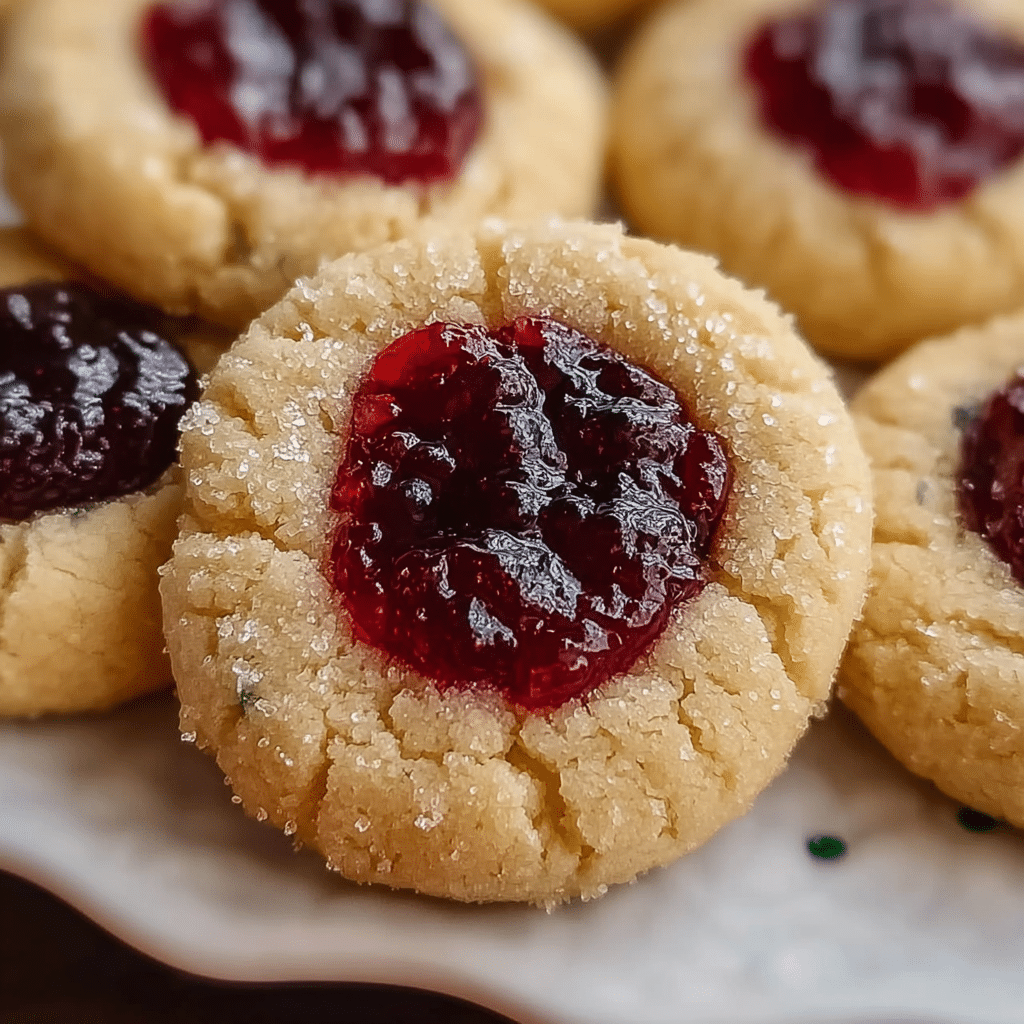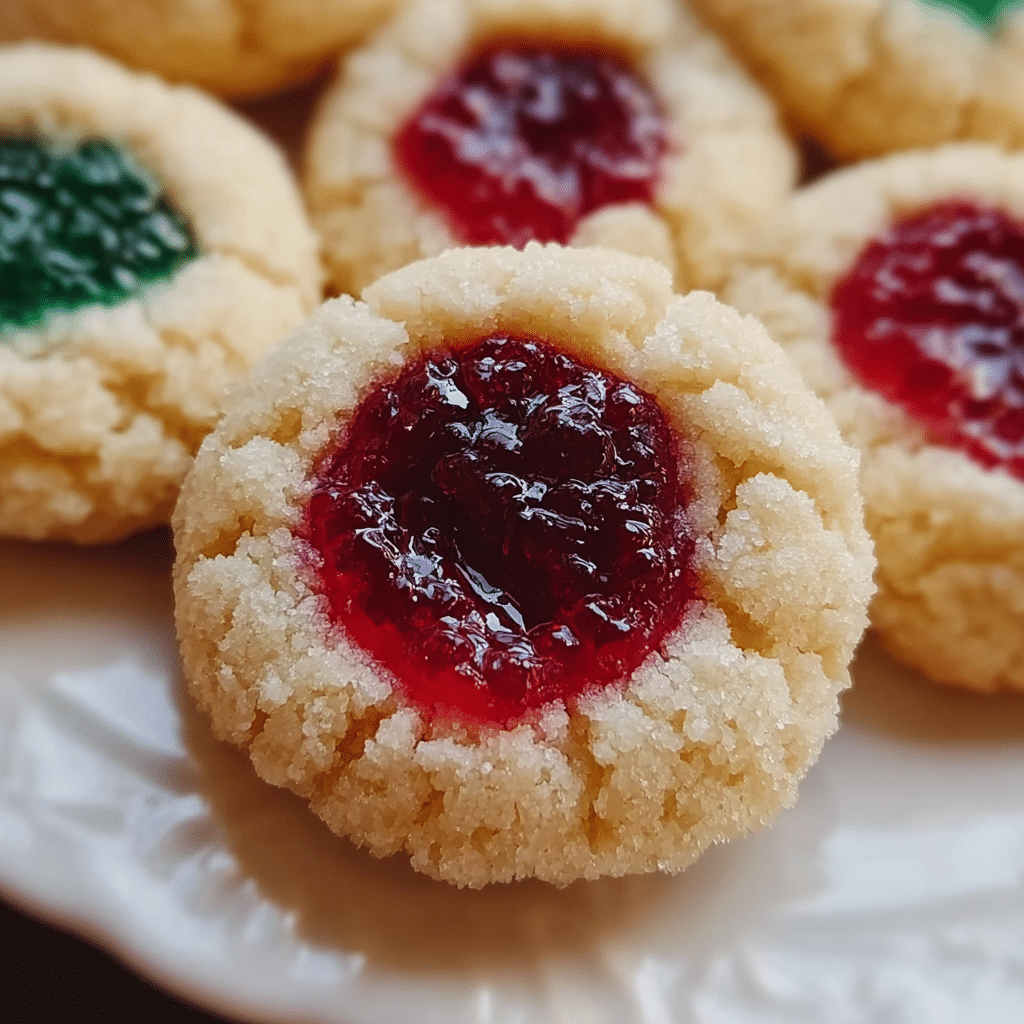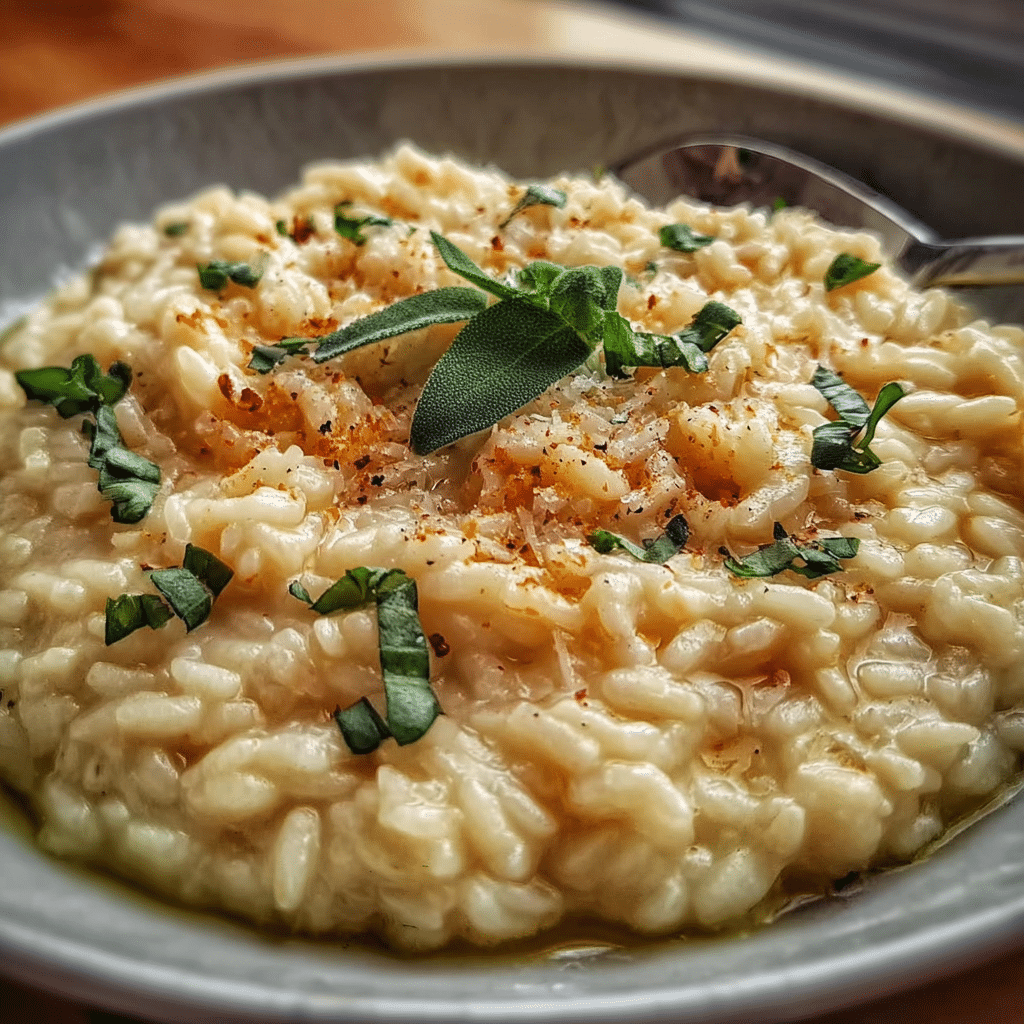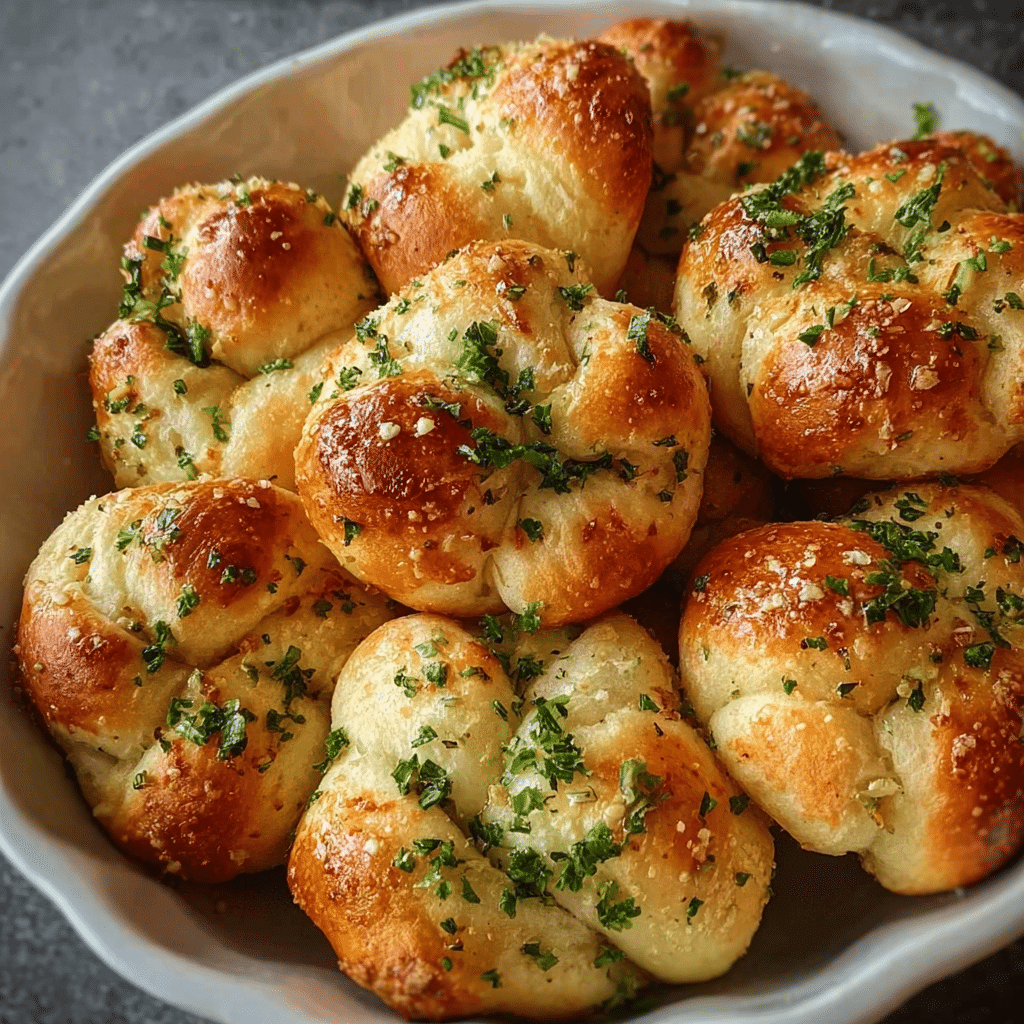Soft Christmas thumbprint cookies are a cherished holiday tradition in many households, and they have a special place in my heart. The first time I made these delightful treats, I was just a young girl, standing on a stool in my grandmother’s warm kitchen, her apron wrapped tightly around my waist. The aroma of vanilla and butter filled the air as we mixed and rolled the dough, a process that felt like magic. As we pressed our thumbs into the soft dough, creating little wells for the vibrant jam, I remember thinking how simple yet beautiful the cookies were. Little did I know that this moment would spark a lifelong love for baking and the joy of sharing sweet treats with family and friends.

Christmas was always a special time in our family, marked by the gathering of loved ones, the twinkling lights, and, of course, the baking of holiday cookies. The soft Christmas thumbprint cookies became a staple during the festive season, often made alongside other classics like gingerbread and peppermint bark. Each bite of these cookies transports me back to those cozy winters spent with my grandmother, a time filled with laughter, warmth, and the sweet taste of nostalgia. This is the beauty of soft Christmas thumbprint cookies: they are more than just delicious treats; they are a vessel for memories and connections that transcend generations.
The Story Behind This Recipe
Soft Christmas thumbprint cookies have a rich history that dates back to the early 19th century. While the exact origin remains somewhat unclear, thumbprint cookies have been a part of various European baking traditions, particularly in Scandinavian countries. In Sweden, for example, the use of fruit preserves in cookies is a common practice, and these thumbprint cookies often feature a dollop of lingonberry jam, a nod to the region’s culinary heritage.
What sets soft Christmas thumbprint cookies apart from other holiday cookies is their unique texture and flavor profile. Unlike traditional cookies that can be crisp and crunchy, these thumbprints are soft, buttery, and chewy, providing a delightful contrast to the sweet, tart filling. The combination of flavors—rich butter, sweet granulated sugar, and the burst of fruit preserves—creates an irresistible treat that is perfect for cookie exchanges and festive gatherings.
For busy families, especially during the hectic holiday season, soft Christmas thumbprint cookies are an ideal baking solution. They come together quickly, requiring minimal effort and time. With just a handful of ingredients and an easy-to-follow recipe, you can whip up a batch in no time, allowing you to spend more quality moments with your loved ones. Plus, the kids can easily get involved, pressing their thumbs into the cookies and choosing their favorite fillings, making it a fun family activity.
The seasonal relevance of soft Christmas thumbprint cookies cannot be overstated. They are the kind of cookie that evokes the spirit of the holidays, making appearances at cookie swaps, office parties, and family gatherings. The bright colors of the jams used for filling—raspberry, apricot, or even a rich chocolate ganache—add a festive touch to any dessert table. For me, the sight of these cookies brings a wave of nostalgia and excitement, reminding me of the warmth and joy that the holiday season brings.
As you delve into this guide, you will learn the secrets to making the perfect soft Christmas thumbprint cookies, from selecting the right ingredients to mastering the art of thumbprinting. You’ll discover tips for making them ahead of time, storing them, and even how to customize the fillings to suit your family’s tastes. By the end of this journey, you’ll not only be equipped with a delicious recipe but also a deeper appreciation for the joy that these cookies can bring into your home.
The Rich History and Cultural Significance of soft christmas thumbprint
The rich history and cultural significance of soft Christmas thumbprint cookies reflect a culinary journey that spans continents and generations. These delightful cookies, known for their soft texture and vibrant jam fillings, have evolved over the years, becoming a holiday favorite in many cultures. As we explore the origins and adaptations of this beloved treat, we uncover a story that intertwines tradition, celebration, and the joy of baking.
Origins and History
Though the precise origins of soft Christmas thumbprint cookies are difficult to pinpoint, many historians suggest that the concept of thumbprint cookies can be traced back to 19th-century Europe. It is believed that these cookies originated in the Scandinavian region, where bakers would create small rounds of dough and use their thumbs to make an indentation, which was then filled with fruit preserves. This method of cookie-making was not only practical, as it allowed for easy filling, but also visually appealing, showcasing the colorful jams and jellies.
In Sweden, these cookies—known as “Hallongrottor,” meaning “raspberry caves”—are traditionally made with a buttery dough and filled with raspberry jam, reflecting the country’s love for berries. The use of preserves in cookies was a way to preserve the bounty of summer fruits, allowing families to enjoy them throughout the winter months. As these cookies gained popularity, they spread to other regions, including Germany and the United States, where variations began to emerge.
In North America, soft Christmas thumbprint cookies became a staple in many households during the holiday season. With the introduction of new flavors and fillings, such as chocolate, caramel, and various fruit jams, the cookies adapted to local tastes and preferences. This evolution has allowed soft Christmas thumbprint cookies to maintain their status as a beloved holiday treat, cherished by families from all walks of life.
Cultural Significance
The cultural significance of soft Christmas thumbprint cookies is deeply rooted in the traditions of family and community. In many cultures, baking during the holidays is a way to honor family recipes and pass down culinary skills from one generation to the next. The act of baking together fosters a sense of connection and celebration, reinforcing the bonds between family members.
During the festive season, soft Christmas thumbprint cookies are often served at gatherings, cookie exchanges, and holiday parties. They are a symbol of hospitality and generosity, as families often share their baked goods with neighbors, friends, and colleagues. This sharing of treats not only spreads joy but also strengthens community ties, creating a sense of belonging and togetherness.
Additionally, these cookies are often associated with holiday traditions, such as decorating the Christmas tree or singing carols. They evoke feelings of nostalgia and warmth, reminding us of the importance of family, love, and togetherness during the holiday season. Each cookie becomes a vessel for cherished memories, with every bite encapsulating the joy of festive gatherings and the laughter shared around the table.
Nutritional Benefits
While soft Christmas thumbprint cookies are undoubtedly a sweet indulgence, they also offer some nutritional benefits, especially when made with wholesome ingredients. The base of these cookies typically includes butter, sugar, flour, and eggs, which provide essential nutrients such as protein, calcium, and vitamins. When using whole grain flour or adding nuts, the cookies can be enriched with fiber and healthy fats, making them a more nutritious option for holiday treats.
Moreover, the use of fruit preserves as a filling adds a natural sweetness and can provide some vitamins and antioxidants, depending on the type of jam used. Opting for lower-sugar or homemade jams can also elevate the health quotient of these cookies, allowing families to enjoy them without guilt.
In conclusion, soft Christmas thumbprint cookies are not just a delightful treat but a celebration of culture, tradition, and family. Their rich history, cultural significance, and potential nutritional benefits make them a perfect addition to any holiday spread. As you embark on your baking journey, you are not just creating cookies but also continuing a legacy that has brought joy to families for generations.
Essential Ingredients for Perfect soft christmas thumbprint
When it comes to baking, every ingredient plays a crucial role in achieving the perfect texture and flavor. For our soft Christmas thumbprint cookies, selecting the right ingredients is essential to ensure they turn out soft, chewy, and bursting with flavor. Below, we’ll dive into the ingredients needed for this delightful holiday treat, exploring their importance, quality indicators, sourcing tips, and even some substitutions for those with dietary restrictions.
Essential Ingredients
- 1 cup (226 g) unsalted butter, softened to room temperature: Butter is the star of the show in our soft Christmas thumbprint cookies. It provides rich flavor and contributes to the tender, melt-in-your-mouth texture. Always choose unsalted butter for baking, as it allows you to control the saltiness of your cookies.
- 1/3 cup (70 g) sugar: Granulated sugar adds sweetness and helps to create a delightful crispness on the cookie’s exterior. When mixed with butter, it creates air pockets that contribute to the cookie’s overall lightness.
- 1/3 cup (70 g) light brown sugar, tightly packed: Brown sugar not only sweetens the cookies but also adds moisture and a slight chewiness due to its molasses content. This depth of flavor is essential for a well-rounded cookie.
- 1 large egg yolk: The egg yolk provides richness and helps bind the ingredients together. It enhances the cookie’s texture, making them soft and tender.
- 3/4 teaspoon vanilla extract: Vanilla extract is the perfect flavor enhancer, bringing warmth and sweetness that complements the other ingredients beautifully. Always opt for pure vanilla extract for the best flavor.
- 2 1/4 cups (280 g) all-purpose flour: This is the main structure of your cookies. All-purpose flour provides just the right amount of gluten to create a tender cookie without being too dense.
- 2 teaspoons cornstarch: Cornstarch is a secret ingredient that helps to create a softer texture by tenderizing the flour. It helps absorb moisture and contributes to that soft bite we crave in our soft Christmas thumbprint cookies.
- 1/2 teaspoon salt: Salt enhances the flavors in the cookies. It’s a crucial component that balances the sweetness and brings out the rich flavors of butter and sugar.
- 1/2 cup sugar for rolling (optional): Rolling the dough balls in sugar before baking adds a lovely sparkle and a slight crunch to the exterior of the cookies, making them even more inviting.
- 1/3 cup (105 g) jam or preserves (flavor of your choice): This is where the magic happens! The thumbprint is filled with your choice of jam or preserves, providing a burst of fruity flavor. Raspberry preserves are a classic choice, but feel free to experiment with strawberry, apricot, or even chocolate ganache!

Soft Christmas Thumbprint Cookies
Ingredients
- 1 cup (226 g) unsalted butter softened to room temperature
- ⅓ cup (70 g) sugar
- ⅓ cup (70 g) light brown sugar, tightly packed
- 1 large egg yolk
- ¾ teaspoon vanilla extract
- 2 ¼ cup (280 g) all purpose flour
- 2 teaspooons cornstarch
- ½ teaspoon salt
- ½ cup sugar for rolling (optional)
- ⅓ cup (105 g) jam or preserves flavor of your choice — I used raspberry preserves for this recipe
Instructions
- Place butter in the bowl of a stand mixer (you may instead use a large bowl and an electric hand mixer) and beat until creamy.
- 1 cup (226 g) unsalted butter
- Scrape down the sides of the bowl, add sugars, and beat, gradually increasing mixer speed to medium-high until ingredients are well-combined (about 30-60 seconds).
- ⅓ cup (70 g) sugar,⅓ cup (70 g) light brown sugar, tightly packed
- Add egg yolk and vanilla extract and beat well.
- 1 large egg yolk,¾ teaspoon vanilla extract
- In a separate bowl, whisk together flour, cornstarch, and salt.
- 2 ¼ cup (280 g) all purpose flour,2 teaspooons cornstarch,½ teaspoon salt
- With mixer on low speed, gradually add flour mixture to wet ingredients until completely combined. This dough will seem very dry and crumbly, so be sure to pause occasionally to scrape the sides and bottom of the bowl. If it starts to strain your mixer you can use your hands to finish working the dough together.
- Scoop cookie dough into 1 Tablespoon-sized balls and roll very well (so that the dough is round and there are no cracks/seams in the cookie dough — this will help keep your thumbprints from cracking).
-
Roll in granulated sugar (if using) and place on a wax-paper covered plate or small cookie sheet. Use your thumb or the rounded back of a teaspoon to gently press an indent in the center of the cookie dough. Repeat until all of the dough has been used.½ cup sugar
-
Transfer cookie dough to freezer and chill for 30 minutes.
-
Once dough is done chilling, preheat oven to 375F (190C) and place your jam in a small microwave-safe bowl. Heat briefly (about 5-10 seconds) or until jam is not hot but is no longer firm and is easy to stir.⅓ cup (105 g) jam or preserves
-
Spoon jam into each thumbprint, filling each indent to the brim.
-
Once oven is preheated, place cookies at least 2″ apart on a parchment paper-lined cookie sheet and bake on 375F (190C) for 11 minutes or until edges are just beginning to turn golden brown.
-
Allow cookies to cool completely on baking sheet before enjoying.
Shopping Tips
When shopping for the ingredients for your soft Christmas thumbprint cookies, quality matters. Here are some tips to ensure you select the best:
- Butter: Look for high-fat butter, as it will give you the best texture and flavor. Organic butter can be a great choice if you’re willing to spend a little more.
- Sugars: Always check for freshness. Brown sugar should be moist and tightly packed, while granulated sugar should be free of clumps.
- Eggs: Choose large, fresh eggs. Organic or free-range eggs are often richer and can enhance the flavor of your cookies.
- Flour: Use a reputable brand of all-purpose flour. Check the expiration date to ensure freshness.
- Jam or Preserves: Opt for natural varieties with no artificial flavors or colors for the best taste.
Substitutions and Alternatives
If you have dietary restrictions or simply want to make some substitutions in your soft Christmas thumbprint cookies, here are some alternatives:
- Dairy-free butter: For a dairy-free version, consider using coconut oil or a plant-based butter substitute.
- Gluten-free flour: You can substitute all-purpose flour with a gluten-free flour blend, but be sure to check if it includes xanthan gum, which helps mimic the texture of gluten.
- Vegan substitute for egg yolk: Use a flax egg (1 tablespoon ground flaxseed mixed with 2.5 tablespoons water) or commercial egg replacers.
When storing your ingredients, keep butter, eggs, and jam in the refrigerator, while flour and sugars can be stored in a cool, dry place. Using quality ingredients not only enhances the flavor but also makes your baking experience enjoyable. With this knowledge, you’re all set to gather your ingredients and start baking those delightful soft Christmas thumbprint cookies!
Detailed Step-by-Step soft christmas thumbprint Cooking Instructions
Creating the perfect batch of soft Christmas thumbprint cookies is not just about mixing ingredients; it’s an art form that involves careful attention to detail, timing, and technique. In this section, we will walk through each step of the process to ensure your cookies come out soft, chewy, and beautifully filled with jam.
Preparation Steps
- Gather Your Ingredients: Begin by assembling all your ingredients on a clean countertop. This mise en place technique not only makes the process smoother but also ensures you don’t forget any critical components for your soft Christmas thumbprint cookies.
- Preheat Your Oven: Preheat your oven to 350°F (175°C). Preheating is essential for achieving the right texture. A hot oven helps the cookies rise quickly, creating that soft, tender structure we love.
- Prepare Your Baking Sheets: Line your baking sheets with parchment paper. This not only prevents sticking but also makes cleanup a breeze. If you don’t have parchment paper, silicone baking mats are a great alternative.
- Soften the Butter: Ensure your unsalted butter is at room temperature, which makes it easier to cream with the sugars. To soften butter quickly, cut it into small cubes and let it sit for about 10-15 minutes.
- Measure Your Ingredients Accurately: Use a kitchen scale for precise measurements, especially for flour and sugar. This accuracy is crucial in baking, where too much or too little can alter the final product.
Cooking Process
- Cream the Butter and Sugars: In a large mixing bowl, combine the softened butter, granulated sugar, and brown sugar. Using an electric mixer, cream them together on medium speed until the mixture is light and fluffy, about 2-3 minutes. This step is vital as it incorporates air into the batter, leading to a lighter cookie.
- Add the Egg Yolk and Vanilla: Beat in the egg yolk and vanilla extract until fully combined. The mixture should look smooth and creamy at this point.
- Combine Dry Ingredients: In a separate bowl, whisk together the all-purpose flour, cornstarch, and salt. Gradually add this mixture to the wet ingredients, mixing on low speed until just combined. Avoid overmixing, as this can lead to tough cookies.
- Chill the Dough: For best results, let the dough chill in the refrigerator for about 30 minutes. Chilling firms up the dough, making it easier to handle and preventing the cookies from spreading too much in the oven.
- Shape the Cookies: Once chilled, scoop out tablespoon-sized portions of dough and roll them into balls. If desired, roll each ball in granulated sugar for added sparkle before placing them on the prepared baking sheets.
Final Assembly
- Create the Thumbprint: Using your thumb (or the back of a spoon), gently press into the center of each dough ball to create a small indentation. Be careful not to press too hard; you want a well-defined thumbprint without breaking the dough.
- Fill with Jam: Spoon about 1/2 teaspoon of your chosen jam or preserves into each thumbprint. Be cautious not to overfill, as the jam can bubble over during baking.
- Bake the Cookies: Place the baking sheets in the preheated oven and bake for 12-15 minutes, or until the edges are lightly golden. The centers may look a bit soft, but they will firm up as they cool, giving you that soft, tender texture we aim for with our soft Christmas thumbprint cookies.
- Cool the Cookies: Once baked, remove the cookies from the oven and allow them to cool on the baking sheet for about 5 minutes before transferring them to a wire rack to cool completely. This cooling step is crucial for the cookies to set properly.
- Enjoy and Share: Once cooled, your soft Christmas thumbprint cookies are ready to be enjoyed! Feel free to share them with friends and family, or package them up for holiday gifts. There’s nothing quite like the joy of sharing homemade treats during the festive season.
With these detailed instructions, you’re well on your way to mastering the art of baking soft Christmas thumbprint cookies. Remember, practice makes perfect, so don’t hesitate to make these cookies a holiday tradition in your home!
Professional Tips and Techniques for soft christmas thumbprint
When it comes to making the perfect soft Christmas thumbprint cookies, mastering the art of cookie baking is essential. These delightful treats are not just any cookies; they are a holiday tradition that brings warmth and joy into our homes. They are soft, chewy, and filled with a luscious jam or chocolate center, making them a favorite during the festive season. In this section, we will dive deep into professional tips and techniques that will elevate your soft Christmas thumbprint cookie game.
Professional Techniques
Let’s start with the basics. The key to achieving that soft, melt-in-your-mouth texture lies in the creaming method. This involves beating together the butter and sugar until the mixture is light and fluffy. The air pockets created during this process help the cookies rise and maintain a soft texture. It’s also crucial to use room temperature ingredients—both the butter and eggs should be at room temperature to ensure a smooth and even mixture.
For a richer flavor, consider browning your butter before adding it to the sugar. This technique adds a nutty depth that can make your soft Christmas thumbprint cookies truly exceptional. To brown butter, simply melt it in a saucepan over medium heat and continue cooking until it turns a golden brown and develops a fragrant aroma, being careful not to burn it.
When it comes to the flour, always measure it correctly. Too much flour can lead to dry cookies. For the best results, spoon the flour into your measuring cup and level it off with a knife. You might also want to sift the flour, which can aerate it and lead to lighter cookies.

Troubleshooting Guide
Even with the best techniques, things can sometimes go awry in the kitchen. If your soft Christmas thumbprint cookies end up too flat, it could be due to insufficient chilling time. Chilling the dough for at least an hour helps solidify the fats, preventing the cookies from spreading too much in the oven.
Another common issue is cookies that are too hard. This can happen if they are overbaked. Keep a close eye on the cookies and remove them from the oven as soon as the edges start to turn golden while the centers still look slightly underbaked. They will continue to cook on the baking sheet after being removed from the oven.
If your thumbprint wells are not holding the jam as expected, it’s possible that the indentation was too shallow. Use your thumb or the back of a measuring spoon to create a deeper well to hold that delicious filling.
Presentation Tips
Presentation is key when it comes to holiday baking. For your soft Christmas thumbprint cookies, consider using a variety of colorful jams or fillings to create an eye-catching display. Raspberry, apricot, and even chocolate ganache can add a pop of color and flavor.
Arrange the cookies on a decorative platter and dust them with powdered sugar for a festive touch. You can also package them in clear cellophane bags tied with a ribbon for a charming gift idea. This not only elevates the presentation but also spreads the joy of baking with loved ones.
For drink pairings, consider serving your soft Christmas thumbprint cookies with a warm cup of spiced apple cider or a rich hot chocolate. The flavors will complement each other beautifully, creating a cozy experience that embodies the essence of the holiday season.
Lastly, remember that these cookies can be made ahead of time. They freeze beautifully, so you can prepare them weeks in advance. Just store them in an airtight container, and when you’re ready to serve, let them thaw at room temperature.
Creative Variations and Adaptations of soft christmas thumbprint
The beauty of soft Christmas thumbprint cookies lies in their versatility. While the classic version is undeniably delicious, there are countless ways to adapt this cookie to suit different tastes and dietary preferences. In this section, we will explore creative variations and adaptations that will keep your holiday baking exciting and inclusive.
Seasonal Variations
One of the easiest ways to switch up your soft Christmas thumbprint cookies is by using seasonal ingredients. For a festive twist, try adding spices like cinnamon or nutmeg to the dough, evoking the warm flavors of the season. You can also incorporate crushed peppermint candies or bits of toffee for added texture and flavor.
Another delightful seasonal variation is to switch out the jam for seasonal fruit preserves. Cranberry-orange or spiced pear jam can add a unique flavor profile that is perfect for the holidays. You can even make your own fruit preserves if you’re feeling adventurous, providing a homemade touch to your cookies.
Dietary Adaptations
With the rise of various dietary needs, adapting your soft Christmas thumbprint cookies has never been easier. For those following a vegan diet, substitute the butter with coconut oil or a vegan butter alternative. Use flax eggs (1 tablespoon ground flaxseed mixed with 2.5 tablespoons water) to replace the eggs, and ensure that your jam is also vegan-friendly.
For gluten-free adaptations, you can use a 1:1 gluten-free flour blend, which will give you a similar texture without sacrificing taste. Just ensure that your baking powder is also gluten-free. If you want to reduce sugar, consider using natural sweeteners like maple syrup or agave, adjusting the flour content accordingly to maintain the dough’s consistency.
Creative Twists
Don’t shy away from experimenting with flavors! For a chocolate lover’s dream, try making a chocolate thumbprint dough and filling it with chocolate ganache or Nutella. Alternatively, add a splash of almond extract to the dough for a sophisticated twist that pairs beautifully with raspberry or cherry filling.
If you want to add some crunch, consider incorporating nuts directly into the dough or rolling the cookies in chopped nuts before baking. This not only adds texture but also elevates the flavor profile, creating a delightful contrast between the soft cookie and the crunchy nuts.
For those with leftovers, don’t let them go to waste! Transform your soft Christmas thumbprint cookies into a delicious trifle. Layer crumbled cookies with whipped cream and seasonal fruits in a glass dish for a stunning dessert that will impress your guests.
In conclusion, the possibilities for variations on the classic soft Christmas thumbprint cookie are endless. Whether you opt for seasonal ingredients, dietary adaptations, or creative twists, the goal remains the same—to create a cookie that brings joy and warmth to your holiday gatherings. So roll up your sleeves, gather your ingredients, and let your imagination run wild in the kitchen this holiday season!
Storage, Reheating, and Meal Prep for soft christmas thumbprint
When it comes to baking, especially during the festive season, one of the key concerns is how to properly store those delightful treats. Soft Christmas thumbprint cookies, with their rich textures and flavorful fillings, deserve the best care to maintain their quality and taste. Today, let’s dive deep into the world of storage, reheating, and meal prep strategies for these luscious cookies.
Short-term Storage
After baking your soft Christmas thumbprint cookies, it’s essential to store them properly to keep them fresh for as long as possible. If you plan to consume them within a week, the refrigerator can be your best friend. Start by allowing the cookies to cool completely on a wire rack. This step prevents condensation from forming inside your storage container, which could lead to sogginess.
For short-term storage, use an airtight container made of glass or high-quality plastic. Layer parchment paper between the cookies to avoid them sticking together, especially if you have used a sticky filling like jam or chocolate. This method not only keeps the cookies separated but also preserves their texture. Store the container in the refrigerator to keep your soft Christmas thumbprint cookies fresh.
It’s also worth mentioning that if you have any leftover icing or filling, store it separately in a small, airtight container. You can use this for touch-ups when you’re ready to serve or add a new layer of flavor to the cookies later in the week.
Freezing and Long-term Storage
If you want to enjoy your soft Christmas thumbprint cookies for a more extended period, freezing is an excellent option. This method allows you to bake them in advance without sacrificing quality. To freeze your cookies, follow these steps: first, ensure the cookies are completely cooled. Then, place them in a single layer on a baking sheet and freeze them for about an hour. This process, known as flash freezing, helps the cookies retain their shape and prevents them from sticking together.
Once frozen, transfer the cookies into a freezer-safe airtight container or a heavy-duty freezer bag. Be sure to label the container with the date and type of cookie for easy identification in the future. Properly stored, soft Christmas thumbprint cookies can last in the freezer for up to three months. When you’re ready to indulge, simply remove the desired amount from the freezer and allow them to thaw at room temperature for about 30 minutes.
For even better results, consider freezing the cookie dough itself. Scoop the dough into balls and freeze them in a similar manner as above. When you’re ready to bake, you can bake the cookies directly from frozen; just add a couple of extra minutes to the baking time.
Reheating Best Practices
There’s nothing quite like the warm, gooey feeling of a freshly baked cookie, even if it was baked a few days ago! To reheat your soft Christmas thumbprint cookies without compromising their delightful texture, preheat your oven to a low temperature, around 300°F (150°C). Place the cookies on a baking sheet lined with parchment paper and warm them for about 5-10 minutes. This gentle reheating method revives the cookies’ softness and brings out the flavors of the fillings.
Alternatively, if you’re in a hurry, the microwave can serve as a quick solution. Place a cookie on a microwave-safe plate and cover it with a damp paper towel. Heat for about 10-15 seconds. Be mindful not to overdo it, as microwaving for too long can lead to chewy, less enjoyable cookies.
When reheating, consider adding a small dollop of fresh jam or a sprinkle of powdered sugar on top to enhance the experience and offer a fresh twist to your soft Christmas thumbprint cookies.
Food safety is always a priority, especially during the bustling holiday season. Ensure that cookies have been stored at the appropriate temperature and consumed within the recommended time frames. A good rule of thumb is to avoid leaving them out at room temperature for more than two hours to prevent any risk of spoilage.
In conclusion, with the right storage methods, your soft Christmas thumbprint cookies can remain a delightful treat throughout the festive season and beyond. Whether you opt for short-term refrigeration or long-term freezing, these strategies will ensure that every bite remains as soft and flavorful as the first. So go ahead, bake a batch (or two), and enjoy the sweet delights of the holidays!
Nutritional Benefits and Health Information
As we indulge in the sweet and comforting world of soft Christmas thumbprint cookies, it’s essential to consider their nutritional impact. Beyond being a festive treat, these cookies can offer a delightful balance of flavors and textures, and by understanding their nutritional profile, we can savor them more mindfully. Let’s explore the key components, health benefits, and dietary considerations surrounding these beloved cookies.
Nutritional Profile
Soft Christmas thumbprint cookies typically consist of basic ingredients such as flour, sugar, butter, eggs, and filling, which can vary from fruit preserves to chocolate or nut butters. A typical cookie (around 30 grams) carries about 100-150 calories, depending on the ingredients and portion size. The macronutrient distribution generally reveals that these cookies are rich in carbohydrates, primarily from the flour and sugar, with a moderate amount of fat from butter and eggs.
Here’s a rough breakdown of the macronutrients you can expect in one cookie:
- Calories: 100-150
- Carbohydrates: 15-20 grams
- Protein: 1-2 grams
- Fat: 4-6 grams
While these numbers can vary based on specific recipes and portion sizes, they provide a general idea of what you’re enjoying when biting into a soft Christmas thumbprint cookie.

Health Benefits
Although soft Christmas thumbprint cookies are primarily a dessert, they can provide some health benefits depending on the fillings used. For example, if you choose fruit preserves made from real fruit, you can enjoy a dose of vitamins and antioxidants, such as vitamin C and various phytonutrients, which are beneficial for immune support. Using nut butters as a filling can add healthy fats and protein, which can help balance out the sugar content and provide sustained energy.
Moreover, if you experiment with whole grain flours or alternative sweeteners, you can increase the fiber content, which aids digestion and promotes a feeling of fullness. These modifications can turn your soft Christmas thumbprint cookies into a slightly healthier treat, allowing you to enjoy the festive season without compromising your dietary goals.
Dietary Considerations
When it comes to dietary considerations, it’s important to be mindful of allergens and dietary restrictions. Traditional soft Christmas thumbprint cookies are not suitable for individuals with gluten intolerance or celiac disease, as they typically contain all-purpose flour. However, gluten-free alternatives, such as almond flour or gluten-free all-purpose flour, can easily be substituted, providing a delicious option for those who need them.
Sugar content is another consideration. Those monitoring their sugar intake, whether due to diabetes or other health concerns, can experiment with sugar substitutes like stevia or erythritol, which can maintain the sweetness without the calorie burden.
Additionally, be aware of potential nut allergies. If you’re preparing these cookies for a gathering, it’s wise to clearly label them, especially if you’ve used nut-based fillings like almond or hazelnut butter.
In conclusion, while soft Christmas thumbprint cookies are undeniably a festive indulgence, they also carry nutritional value that can be appreciated. By understanding their nutritional profile, recognizing potential health benefits, and considering dietary modifications, you can enjoy these cookies in a way that aligns with your personal health goals. So go ahead, gather your loved ones, bake a batch, and celebrate the season with this delightful treat, all while being mindful of the nourishment it can provide!
Frequently Asked Questions About Soft Christmas Thumbprint
Soft Christmas thumbprint cookies recipe
To make soft Christmas thumbprint cookies, start by creaming together 1 cup of softened butter and 1 cup of sugar until fluffy. Then, add 2 egg yolks and 1 teaspoon of vanilla extract, mixing until well combined. Gradually incorporate 2 cups of all-purpose flour and a pinch of salt, forming a soft dough. Once your dough is ready, roll it into small balls, place them on a baking sheet, and use your thumb to create indentations. Bake at 350°F (175°C) for 10-12 minutes, then fill the thumbprints with your favorite jam or chocolate before cooling. For an extra festive touch, consider adding crushed peppermint or holiday sprinkles on top of the filling!
Soft Christmas thumbprint cookies with icing
To elevate your soft Christmas thumbprint cookies with icing, begin by following the basic thumbprint cookie recipe. Once the cookies have cooled, prepare a simple icing by whisking together 1 cup of powdered sugar with 2-3 tablespoons of milk and a splash of vanilla extract until smooth. Drizzle or pipe this icing over the cooled cookies for a beautiful finish. For added flair, consider tinting the icing with food coloring to match your holiday theme or sprinkle edible glitter on top before the icing sets. This not only enhances the flavor but also adds a delightful visual appeal to your festive treats!
Old fashioned thumbprint cookies
Old fashioned thumbprint cookies typically feature a buttery base and are filled with fruit preserves or chocolate. To achieve that classic taste, use a recipe that includes ingredients like brown sugar for added richness and vanilla extract for enhanced flavor. After rolling the dough into balls, use a spoon or your thumb to create deep indentations for the filling. Baking these cookies at a lower temperature, around 325°F (160°C), can help maintain their soft texture and prevent over-browning. For a nostalgic touch, consider using traditional fillings like raspberry or apricot preserves, which evoke a sense of holiday warmth.
Easy soft Christmas thumbprint cookies
If you’re looking for an easy recipe for soft Christmas thumbprint cookies, try using a pre-made cookie mix as a base. Simply follow the instructions on the package but add an additional egg and a teaspoon of vanilla extract for a richer flavor. After baking, create indentations as you would normally and fill them with store-bought jam or chocolate spread to save time. This method allows you to enjoy homemade cookies without the hassle of measuring and mixing multiple ingredients. Remember to keep an eye on the baking time to ensure they remain soft and chewy!
Best soft Christmas thumbprint cookies
The best soft Christmas thumbprint cookies balance a rich, buttery flavor with a tender, melt-in-your-mouth texture. To achieve this, use high-quality ingredients like unsalted butter and pure vanilla extract. Incorporating cornstarch into your flour mixture can also help create a softer cookie. Ensure that you do not overbake them; they should be just set in the center when you take them out of the oven. Experimenting with various fillings, such as chocolate ganache or spiced apple butter, can also elevate your cookies to the next level, making them a standout treat at any holiday gathering.
3 ingredient thumbprint cookies
3-ingredient thumbprint cookies are a simple yet delightful option for quick baking. For this recipe, combine 1 cup of almond flour, 1/4 cup of honey or maple syrup, and 1/4 cup of melted coconut oil to form a dough. Roll the dough into small balls, place them on a lined baking sheet, and use your thumb to create an indentation before filling it with your favorite jam. Bake at 350°F (175°C) for about 10-12 minutes until they are golden around the edges. This recipe is not only easy but also gluten-free, making it perfect for various dietary preferences!
Types of thumbprint cookies
There are several delightful variations of thumbprint cookies, each offering unique flavors and textures. Traditional thumbprint cookies are typically made with a buttery dough filled with fruit preserves, but you can also find chocolate thumbprint cookies, which use cocoa powder in the dough and are filled with chocolate ganache. For a nutty twist, consider almond or peanut butter thumbprints. Additionally, you can experiment with flavored fillings, such as lemon curd or caramel, to create a personalized touch. Each variation can be decorated differently, allowing you to get creative for the holidays!
Soft thumbprint cookies
Soft thumbprint cookies are characterized by their tender, chewy texture and are best made with a few key techniques. Start with room temperature butter, as this helps create a creamy, fluffy base when mixed with sugar. When adding flour, be careful not to overmix the dough, as this can lead to denser cookies. To ensure they remain soft, underbake them slightly; they should look set but not browned when you take them out of the oven. Storing them in an airtight container with a slice of bread can also help maintain their soft texture for several days!
Conclusion: Mastering the Perfect soft christmas thumbprint
Creating the perfect soft christmas thumbprint is more than just following a recipe—it’s about understanding the techniques, ingredients, and cultural significance behind this beloved dish. Throughout this comprehensive guide, we’ve explored everything from the historical origins to modern variations, ensuring you have all the knowledge needed to make this recipe your own.
Whether you’re a beginner cook or an experienced chef, the techniques and tips we’ve shared will help you create a soft christmas thumbprint that’s not only delicious but also meaningful. Remember that cooking is a journey of discovery, and each time you make this dish, you’ll learn something new.
We encourage you to experiment with the variations we’ve discussed, adapt the recipe to your dietary needs, and most importantly, share it with the people you love. Food has the incredible power to bring people together, and Soft Christmas Thumbprint Cookies is the perfect dish to create lasting memories around your dinner table.





